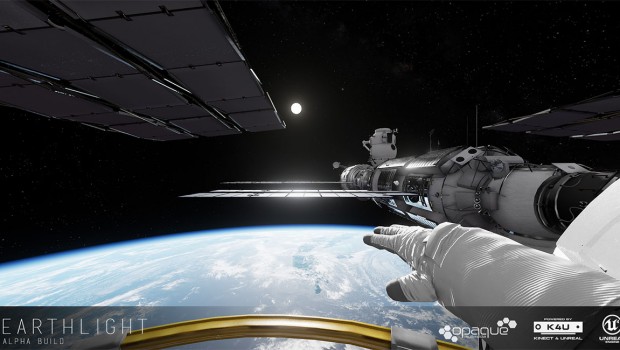VR Demo Transports Players to the International Space Station
Award-winning serious games studio launches tech demo showcasing future of Kinect and Oculus integration in Unreal Engine 4
MELBOURNE, AUSTRALIA, 24th February, 2015 – Opaque Multimedia today officially announced Earthlight, a tech demo designed to demonstrate the immersive power of the Oculus Rift coupled with the Kinect 2. Earthlight will be available at the Opaque Multimedia booth at GDC 2015, with a public release to follow.
Earthlight is a first-person exploration game where the players steps into the shoes of an astronaut on the International Space Station (ISS) where, from 431 kilometres above, they look down on the Earth from within the comfort of their own spacesuit.
Featuring the most realistic depiction of the International Space Station used in an interactive VR setting to-date, Earthlight demonstrates the very limits of what is visually achievable in consumer-oriented VR experiences.
In Earthlight, players interact with the environment entirely through a natural motion interface, pushing and pulling themselves along the surface of the ISS as they navigate a network of handles and scaffolds.
The player’s motion is captured through a Microsoft Kinect 2 and powered by the company’s Kinect 4 Unreal technology.
“Visiting the International Space Station, floating freely in space, is a dream of many but a reality experienced by only a few.” Said Professor Christopher Fluke, Coordinator of the Virtual Reality Theatre at the Centre of Astrophysics and Supercomputing at Swinburne University at a pre-release demonstration of Earthlight.
“Earthlight is a genuinely engaging experience. Within moments of putting on the Oculus Rift headset, I was ready to climb out onto the surface of the Space Station and begin exploring. I am excited by the potential for interactive virtual experiences to play a greater role in bringing dreams of space exploration to life.”
“It’s been a real challenge to create a pleasant UX when you’re trying to combine VR with kinetic input.” says Chris Mackenzie, one of the team members responsible for creating the sophisticated body mapping system that underlies Earthlight. “We have to pay close attention to a number of different factors that you don’t normally have to account for in conventional VR projects, particularly proprioception.”
“Proprioception is the awareness of the position of your body and joints” Chris explains. “When we replace people’s body with a virtual avatar that mimics their movement, we need to ensure that what they’re seeing matches what they think their limbs are doing, otherwise it makes for a deeply disturbing experience”.
“We have really pushed both the software and the hardware to their limit.” Says Norman Wang, Earthlight Project Lead and Art Director at Opaque Multimedia. “We really did put the Kinect 2 through its paces. The Kinect is already pretty good normally, but when you’re in a VR setting where you’re staring at a pair of virtual arms that are centimetres from the camera, we had to eliminate even the slightest bit of jitter while keeping the simulation responsive.”
Earthlight will be available at the Opaque Multimedia booth at GDC 2015, with a public release to follow.







